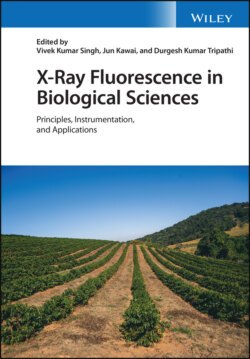Читать книгу X-Ray Fluorescence in Biological Sciences - Группа авторов - Страница 59
4.4.1 Principles of TXRF
ОглавлениеAs stated above, the idea of TXRF application for trace element analysis was first put forward by two Japanese scientists, Yoneda and Horiuchi. Since then this technique has found applications in newer and advanced areas of material characterization [9]. The principles of TXRF analysis are based on the following three fundamental instrumentation changes to tradtional EDXRF:
1 In TXRF, the primary beam falls on the sample/support at an angle less than the critical angle which is <1° for almost all materials and depends on the energy of the X‐ray beam as well as density and atomic number (Z) of the reflector materials. This feature of TXRF ensures that the incident X‐rays do not penetrate deep into the sample supports and hence the scattered background is drastically reduced and leads to far better detection limits compared to conventional XRF.
2 As the primary parallel incident X‐ray beam falls on the sample support at an angle less than the critical angle, the sample support has to be a flat polished surface so that a fixed angle below the critical angle of support can be maintained for the impinging beam to totally reflect from it. In this situation, if a thin film of the sample having thickness of a few nanometers is deposited on the intersection area of the incident and reflected beams, it will be excited by the incident as well as by the totally reflected beams from the support. This arrangement results in almost double excitation of the sample compared to that in EDXRF and thus, increases the intensity of fluorescent X‐rays compared to that in EDXRF by about two times.
3 Since the glancing as well as the reflection angles are generally below one degree (very near to zero degree) the detector can be brought very close to the sample deposited on the support ensuring the angle between the incident X‐ray beam and the detector to be about 90°. This arrangement leads to 0–90° geometry of beam and detector, required for attaining a low background in XRF (here in TXRF).
The above geometrical arrangement takes care of the problems, associated with EDXRF, which are responsible for higher (inferior) detection limits and provides excellent elemental detection limits in TXRF comparable with other trace determination techniques, e.g. ICP‐OES, ICP‐MS, etc. In addition, the sample thickness is very small (a few nm) and hence the matrix effects associated are also negligible [8–10].
